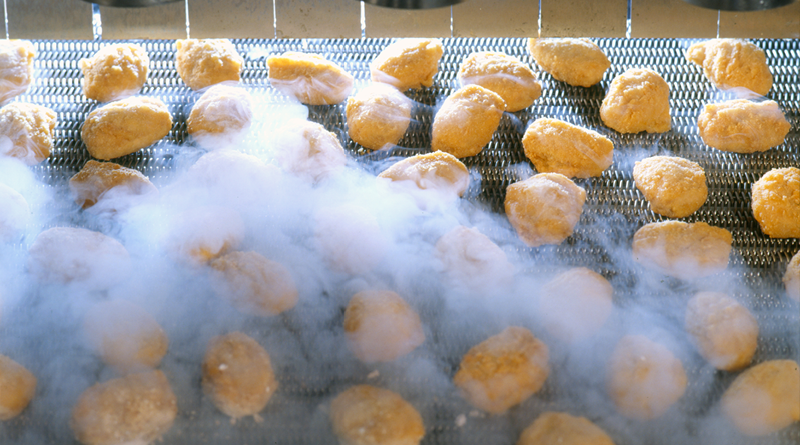Food
With over 100 years experience in the food and beverage industry, we have the know-how to help you optimize your production and freezing processes, lower your costs and improve your:
- Yield
- Production throughput
- Efficiency
- Quality
We do this through:
- Expert food analysis at our Food Technology Lab
- Optimal equipment engineering and design
- Expert set-up and start-up from our experienced field support
First, our dedicated team of food scientists can analyze your specific food product to develop your optimal custom processes. Then, our world-class engineers will recommend and provide the optimal equipment for your needs. Finally, our experienced field team can install, start-up and service your equipment to keep your equipment at top performance.
In short you’ll get the temperature control and atmosphere applications you need, backed by the services and systems support you can expect from Linde.

Comprehensive Product Range
Supplying each application with the proper gas (grade, compliance, certification, scale)
Superior Reliability
Extensive production facilities network to help ensure high-quality products are there when they are needed.
Equipment and Systems Excellence
Connecting customers with everything needed to handle and store gases efficiently and safely
Productivity and Innovation Partner
Working with food industry to identify and implement productivity and cost improvements
Ease of Doing Business
Providing convenient e-commerce options and strong customer support
Safety Focus
Making safety the top priority for every activity
The Linde Food Technology Lab
In our Food Technologies Lab, we can analyze your process and provide you with recommendations on how to improve the quality and consistency of your product. Our lab is a full-time facility that has been in operation for over 30 years. Our experienced and dedicated technicians make their recommendations based on their expertise and the evaluation of data collected from thousands of tests on actual food products, in-lab thermal analyses and product testing on production-scale equipment. We will collect data on the thermal characteristics of your product, determine parameters for your freezing and chilling equipment, show what your product looks and tastes like after freezing and recommend ways to better meet your goals.
We are equipped to answer your most difficult product and processing questions so that you can optimize your system. So whether it’s maximizing yield, boosting production or perfecting your finished product, our experts are ready to help with a customized assessment of your operation.
Food Freezing and Chilling
Food freezing/cooling/chilling is the process of using direct contact of a cryogen to control or adjust temperature to a frozen or chilled state. Both inline and batch type freezing equipment can be designed to use carbon dioxide or nitrogen to freeze, cool or chill the food. The speed of cryogenic refrigeration helps prevent product degradation; the product retains natural
juices and color and dehydration is drastically reduced.
Almost any food product, (e.g., meat, chicken, fish, dairy, bakery, prepared foods, fruit, vegetables, etc.) can benefit from cooling or freezing, depending on the customer’s
needs.
Freezing is generally regarded as a food preservation technique. A customer considers freezing or chilling a food product to obtain higher quality products, extend shelf life, expand the distribution area and make product handling
easier.
The consequences of not achieving the desired final temperature include:
- Product handling problems
- Non-compliance with quality assurance (QA) specifications or government regulations
- Shorter shelf life or reduced product quality
- Supplemental freezing
Proper temperature control (cryogenic freezing or chilling) can greatly reduce (or slow) the loss of food product quality caused by bacteria growth, staling, oxidation and mold growth. This application also can overcome mechanical handling problems encountered in processes like packaging, slicing, dicing and other processing.
What is cryogenic freezing?
Freezing is a change in the physical state of a food product when energy, in the form of heat, is removed, changing the water in the food from the liquid state to a solid state.
Linde specializes in cryogenic freezing using nitrogen or carbon dioxide at low temperatures to quickly freeze food products locking in moisture and product quality.
What is cryogenic chilling?
Cryogenic chilling is the removal of heat from raw and fresh processed foods, cooked or baked foods, and produce at ambient temperatures. Quickly cooling food products is an important step to ensure food safety and improve overall yield.
Linde specializes in rapid chilling using liquid carbon dioxide and employ’s innovative new applications using liquid nitrogen.
Modified Atmosphere Packaging (MAP)
The use of modified atmospheres to replace air in food packages is applicable to many types of food. Controlling food spoilage is complex and more than one gas may be appropriate for the same application. However, specific packaging conditions and shelf
life extension requirements play a role in determining which one is most suitable for a given application.
Linde’s Extendapak® gases are used by food processors and packagers for food preservation. These gases include
pure nitrogen, carbon dioxide and oxygen or a mixture of these products and function to displace unwanted atmospheric gases when used in a Modified
Atmosphere Packaging (MAP) process.
MAP represents only one aspect of what a food processor can use to ensure that safe, high-quality food reaches the marketplace and, ultimately, the consumer.
Most importantly, MAP does not
eliminate or reduce the processor’s responsibility for good manufacturing practices. In fact, the opposite is true. MAP is only appropriate for plants producing the cleanest of products. No gas combination in the package will ever reverse a
food’s poor microbial condition. At its best, MAP will only extend the keeping quality of a food.




























